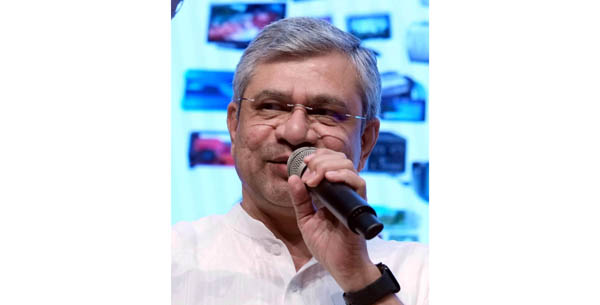Rs 23K cr PLI scheme for electronics component
NEW DELHI, Mar 28:
The Union Cabinet on Friday increased the Dearness Allowance (DA) by 2 percentage points effective from January 1 this year, benefitting nearly 1.15 crore Central Government employees and pensioners.
Follow the Daily Excelsior channel on WhatsApp
The Union Cabinet has approved the release of an additional instalment of Dearness Allowance (DA) to Central Government employees and Dearness Relief (DR) to pensioners with effect from January 1, 2025, representing an increase of 2 per cent over the existing rate of 53 per cent of the basic pay/pension, to compensate against price rise, said Information and Broadcasting Minister Ashwini Vaishnaw after the Cabinet meeting.
The combined impact on the exchequer on account of increase in both DA and DR would be Rs 6,614.04 crore per annum.
The move will benefit about 48.66 lakh Central Government employees and 66.55 lakhs pensioners.
The increase is in accordance with the accepted formula, which is based on the recommendations of the 7th Central Pay Commission.
DA and DR is paid to adjust the cost of living and protect employees and pensions from inflation.
The Cabinet also approved a production-linked incentive scheme for passive or non-semiconductor electronics components with an outlay of Rs 22,919 crore, Union Electronics and IT Minister Ashwini Vaishnaw said.
It is the first scheme that focuses on promoting the manufacturing of passive electronic components.
The Minister said that the scheme will create direct employment for 91,600 people and attract investment of around Rs 59,350 crore.
“Passive components are approved under the Electronics Component PLI scheme. It has a total package of Rs 22,919 crore. This will be over six years,” Vaishnaw said.
The Minister said that segment will serve the requirements of several sectors, including telecom, consumer electronics, automobile, medical devices, power sector etc.
He said that the scheme is expected to lead to production of Rs 4.56 lakh crore.
According to electronics component makers body Elcina, non-semiconductor components production in India was around USD 13 billion in 2022 which is projected to reach around USD 20.7 billion by 2026 and around USD 37 billion by 2030 if the business continues as usual thereby leading a deficit of USD 248 billion in the segment in the next six years. The deficit is met through imports.
Elcina had sought a USD 8.57 billion (about Rs 72,500 crore) support package to reduce the deficit by Rs 12.36 lakh crore in the next six years.
Electronic Industries Association of India (Elcina) estimates that the deficit in the segment can increase to USD 248 billion (about Rs 21 lakh crore) by 2030 in the absence of government support to local production. The country’s oldest technology industry body projects that the Government’s support could help reduce the deficit in the passive component segment by USD 146 billion (Rs 12.36 lakh crore) to USD 102 billion (Rs 8.63 lakh crore).
Meanwhile, the Cabinet has approved the inclusion of Bihar’s Kosi Mechi Intra-State Link Project under the Pradhan Mantri Krishi Sinchai Yojana-Accelerated Irrigation Benefits Programme (PMKSY-AIBP) to enhance irrigation and flood management in the region.
The project envisages diversion of a part of surplus Kosi water for extending irrigation to Mahananda basin in Bihar by way of remodelling existing Eastern Kosi Main Canal.
Estimated to cost Rs. 6,282.32 crore, the project includes Rs 3,652.56 crore as central assistance to Bihar and is scheduled for completion by March 2029.
Responding to a question during a media briefing after a Cabinet meeting, Union Minister Ashwini Vaishnaw said discussions with Nepal have taken place about the project and it is expected to have a major impact on flood management in Bihar.
Asked whether more such projects would be announced ahead of elections in Bihar, he said decisions were being made “for the entire country”.
The Kosi Mechi Intra-State Link Project aims to divert excess water from the Kosi River to the Mahananda basin in Bihar. This will be achieved through the remodelling of the Eastern Kosi Main Canal (EKMC) up to 41.30 km and its extension to the Mechi River at 117.50 km.
Once completed, the project aims to provide additional irrigation to 2,10,516 hectares of farmland in Araria, Purnea, Kishanganj, and Katihar districts during the Kharif season.
It will also restore the shortfall supply to 1.57 lakh hectares currently irrigated by the existing EKMC system. Additionally, about 2,050 million cubic meters of surplus water from Kosi will be diverted to the Mahananda command area during monsoons.
The project is part of the broader PMKSY-AIBP initiative, which was launched in 2015-16 to expand irrigation coverage and improve water conservation efforts.
The scheme’s Accelerated Irrigation Benefits Programme component focuses on major and medium irrigation projects, with the aim of ensuring water access for farmers.
Since April 2016, 63 projects have been completed under PMKSY-AIBP, creating additional irrigation potential for 26.11 lakh hectares. The Kosi Mechi project is the tenth to be included in the AIBP component since 2021. (PTI)


